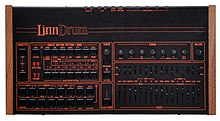LinnDrum
Drum machine From Wikipedia, the free encyclopedia
The LinnDrum, often erroneously referred to as the LM-2,[1] is a drum machine manufactured by Linn Electronics between 1982 and 1985. About 5,000 units were sold.[2][3]
| LinnDrum | |
|---|---|
 LinnDrum digital drum machine | |
| Manufacturer | Linn Electronics |
| Dates | 1982–1985 |
| Price | US$2,995 |
| Technical specifications | |
| Polyphony | polyphonic 12 voices |
| Timbrality | multitimbral 15 parts |
| Synthesis type | 8-bit digital samples, 28–35 kHz |
| Storage memory | 56 user patterns, 42 preset drum patterns, 49 songs |
| Effects | Individual level and pan for all sounds, tuning for snare, tom and conga only |
| Input/output | |
| Keyboard | 15 hard plastic "pads" |
| External control | DIN sync (pre-MIDI), third-party MIDI Retrofit Kit, trigger inputs x5 |
Development
The LinnDrum was designed by the American engineer Roger Linn.[4] It was cheaper and more widely produced than his first drum machine, the Linn LM-1, which had been affordable only to wealthy musicians and studios.[4][5][6]
Release
The LinnDrum sold far more units than the Linn LM-1 and its successor, the Linn 9000, combined.[3] It was used by artists and producers including Trevor Horn,[7] Stock Aitken Waterman,[8] Sandy Vee,[9] Justin Hayward,[10] and Michael Jackson.[11] When Linn Electronics closed in 1986, Forat Electronics purchased its assets and offered service, sounds, and modifications for the LinnDrum.[12][13]
References
External links
Wikiwand - on
Seamless Wikipedia browsing. On steroids.
